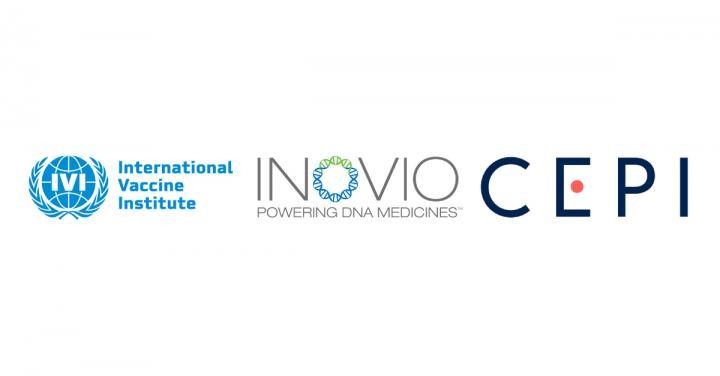- The Coalition for Epidemic Preparedness Innovations (CEPI) grants funding $6.9 million to INOVIO and IVI to conduct clinical testing in Korea for INOVIO’s COVID-19 vaccine candidate based on their well-established DNA platform technology
- Korea National Institute of Health (KNIH) to support IVI’s testing efforts
April 16, 2020, SEOUL, Korea and Plymouth Meeting, Pa. USA – The International Vaccine (IVI) announced today that the Coalition for Epidemic Preparedness Innovations (CEPI) has granted $6.9 million funding to INOVIO (NASDAQ:INO) to work with IVI and the Korea National Institute of Health (KNIH) for Phase I/II clinical trial of INOVIO’s COVID-19 vaccine candidate (INO-4800) in South Korea. IVI will conduct the trial in parallel to INOVIO’s Phase I INO-4800 study currently underway in the US since April 6, 2020 with 40 healthy adults receiving the vaccine candidate and eventually expanding to older adults.
Dr. Jerome H. Kim, Director General of IVI, said, “Vaccines are the long-term solution to controlling the COVID-19 pandemic. The rapid global response to developing vaccine candidates has been a profound demonstration of governments, industry, and the scientific community coming together to confront a common crisis, and we’re looking forward to accelerating one of those candidates through clinical testing. IVI has achieved promising trial results with INOVIO’s DNA vaccine platform in the past, and we’re pleased to partner again to test the safety and immunogenicity of an urgently needed COVID-19 vaccine.”
Dr. J. Joseph Kim, INOVIO’s President and CEO, said, “Developing a safe and effective COVID-19 vaccine is a global imperative, and we’re pleased to partner with IVI and KNIH to test INO-4800 in South Korea. Our DNA vaccine platform was one of the first technologies to receive support from CEPI to accelerate a COVID-19 vaccine, and IVI conducting safety and efficacy trials in South Korea is a crucial step forward in evaluating this vaccine.”
Dr. Richard Hatchett, CEO of CEPI said, “Developing a safe and effective vaccine and ensuring its global supply is our best exit strategy from the COVID-19 pandemic. CEPI is pleased to work with Inovio and IVI in this critical next stage of testing.”
INOVIO’s DNA vaccine platform is also utilized in their MERS vaccine, INO-4700, for which IVI previously conducted Phase I clinical testing with GeneOne Life Science in South Korea.
This news follows the announcement from the Korean Ministry of Food and Drug Safety made on April 13th that they will adopt a fast-track approval process for COVID-19 vaccine and treatment clinical trials. The period of clinical trial screening will be shortened to seven days (down from 30 days) for substances with experience in use and within 15 days for new materials. Additionally, vaccines developed with a proven safety platform, such as INOVIO’s DNA platform, will be exempt from toxicology tests which will minimize data submission and expedite clinical trials. Plumbline Life Sciences (XKRX: 222670) of South Korea will also collaborate on this project. Korea Centers for Disease Control and Prevention (KCDC) and the KNIH have also pledged their support for IVI’s testing efforts.
###
About the International Vaccine Institute (IVI)
The International Vaccine Institute (IVI) is a nonprofit inter-governmental organization established in 1997 at the initiative of the United Nations Development Programme (UNDP). Headquartered in Seoul, South Korea, IVI was the first international organization hosted by Korea. IVI has 35 signatory countries and the World Health Organization (WHO) on its treaty, including Republic of Korea, Sweden and India as state funders.
Our mandate is to make vaccines available and accessible for the world’s most vulnerable people. We focus on infectious diseases of global health importance such as cholera, typhoid, shigella, salmonella, schistosomiasis, Group A Streptococcus, Hepatitis A, HPV, TB, HIV, MERS, COVID-19, as well as antimicrobial resistance. For more information, please visit https:/
About INOVIO
INOVIO is a biotechnology company focused on rapidly bringing to market precisely designed DNA medicines to treat, cure, and protect people from diseases associated with HPV, cancer, and infectious diseases. INOVIO is the first and only company to have clinically demonstrated that a DNA medicine can be delivered directly into cells in the body via a proprietary smart device to produce a robust and tolerable immune response. Specifically, INOVIO’s lead candidate VGX-3100, currently in Phase 3 trials for precancerous cervical dysplasia, destroyed and cleared high-risk HPV 16 and 18 in a Phase 2b clinical trial. High-risk HPV is responsible for 70% of cervical cancer, 90% of anal cancer, and 69% of vulvar cancer. Also in development are programs targeting HPV-related cancers and a rare HPV-related disease, recurrent respiratory papillomatosis (RRP); non-HPV-related cancers glioblastoma multiforme (GBM) and prostate cancer; as well as externally funded infectious disease DNA vaccine development programs in Zika, Lassa fever, Ebola, HIV, and coronaviruses associated with MERS and COVID-19 diseases. Partners and collaborators include Advaccine, ApolloBio Corporation, AstraZeneca, The Bill & Melinda Gates Foundation, Coalition for Epidemic Preparedness Innovations (CEPI), Defense Advanced Research Projects Agency (DARPA)/DOD, GeneOne Life Science/VGXI, HIV Vaccines Trial Network, Medical CBRN Defense Consortium (MCDC), National Cancer Institute, National Institutes of Health, National Institute of Allergy and Infectious Diseases, Ology Bioservices, Plumbline Life Sciences, Regeneron, Roche/Genentech, University of Pennsylvania, Walter Reed Army Institute of Research, and The Wistar Institute. INOVIO also is a proud recipient of 2020 Women on Boards “W” designation recognizing companies with more than 20% women on their board of directors. For more information, visit http://www.
About CEPI
CEPI is an innovative partnership between public, private, philanthropic, and civil society organisations, launched at Davos in 2017, to develop vaccines to stop future epidemics. CEPI has moved with great urgency and in coordination with WHO in response to the emergence of COVID-19. CEPI has initiated 8 partnerships to develop vaccines against the novel coronavirus. The programmes will leverage rapid response platforms already supported by CEPI as well as new partnerships. The aim is to advance COVID-19 vaccine candidates into clinical testing as quickly as possible.
Before the emergence of COVID-19 CEPI’s priority diseases included Ebola virus, Lassa virus, Middle East Respiratory Syndrome coronavirus, Nipah virus, Rift Valley Fever and Chikungunya virus. CEPI also invested in platform technologies that can be used for rapid vaccine and immunoprophylactic development against unknown pathogens (Disease X).
CONTACT
IVI Media:
Youngmi Cho, Head of Global Affairs & Communications, +82-2-881-1439, youngmi.cho@ivi.int
Aerie Em, Global Communications & Media Specialist, +82-2-881-1386, aerie.em@ivi.int
INOVIO Media:
Jeff Richardson, VP of Communications & Strategic Relations, +1-267-440-4211, jrichardson@inovio.com
CEPI:
Rachel Grant, Director of Communications and Advocacy, Rachel.Grant@cepi.net













































